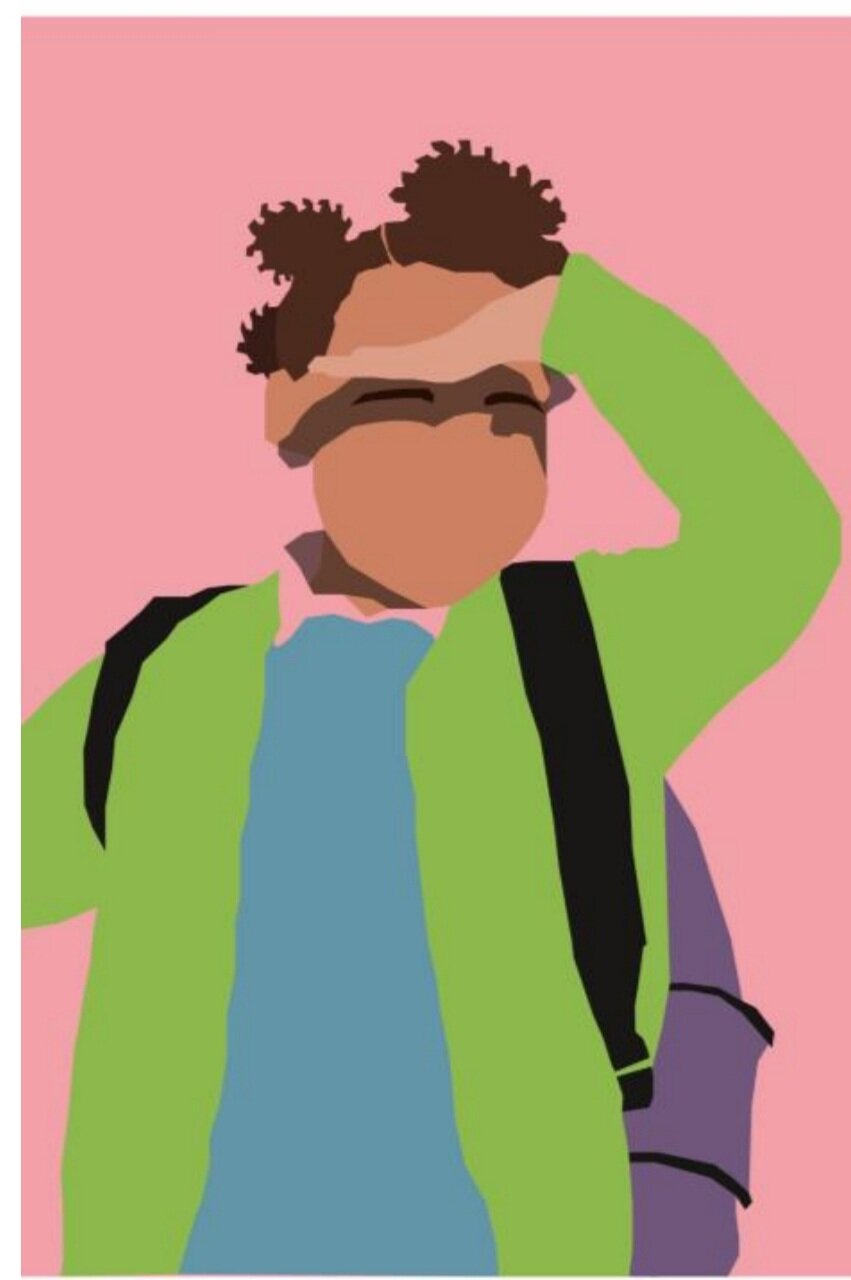Exploring Transformative Inclusion of Black, Indigenous and People of Color Artists in Portland
Written by: Maddy Silberger-Franek and Ameenah Carroll
Research by: Elena Ferry, Maddy Silberger-Franek and Ameenah Carroll
This article presents findings from an ethnographic research project conducted through the Collaborative Design Program at Pacific Northwest College of Art (PNCA). This project was centered around how arts organizations can further foster inclusion of Black, Indigenous, People of Color (BIPOC) who are artists in Portland, Oregon.
Artwork by Nia Musiba
It is no secret that Portland is a very white place. The state of Oregon was founded on notions of white supremacy that are still reflected in the city today. Knowing that Portland can be a particularly challenging place for BIPOC artists to feel “at home,” we sought to have a better understanding of the pathways and barriers of inclusion BIPOC artists faced when trying to build community, enter into, or partner with arts organizations in the city.
To gain a more nuanced view of this issue, we first spoke to Portland Street Art Alliance (PSAA), a non-profit arts organization that focuses on connecting street artists to mural opportunities in the city of Portland and beyond. PSAA provided insights into what their organization is already doing to further inclusion of BIPOC artists and connected the research team to street artists PSAA has worked with in the past. This informed our focus on the remaining research, which centered the experience of mostly street artists. The research team presented the findings of this study to PNCA and PSAA in December 2020.
PSAA connected the research team with four Portland-based street artists. Additional study participants were identified using a snowball sampling approach. Personal community networks identified an additional eight BIPOC artists to interview, with two of these participants having worked at arts organizations. The research team conducted one-hour Zoom interviews with all participants.
Key Insights
1. BIPOC artists struggle to find BIPOC-centered art spaces and opportunities. Many BIPOC artists had to create their own spaces in order to support each other. "Hopefully my friend ____ and I can start a community at our gallery as we're working in Portland. I'm excited for that." For many BIPOC artists, creating their own spaces helps artists not only feel safe, but provides supportive opportunities to share their art. This also helps BIPOC artists connect with other BIPOC artists in their communities.
2. Art organizations hypothesize that their lack of diversity is due to ineffective recruiting methods. Arts organizations need new methods of reaching out to communities. "We are in the process of changing our whole leadership model." Although changing leadership roles to include more people of color in art organizations is becoming a more prevalent topic of discussion, the process of these leadership role transformations is still infrequent. The connections between BIPOC artists and art organizations in Portland is crucial in order for these transformations to occur.
3. BIPOC artists are not represented or included in Portland galleries because the gallery culture is not accessible to newcomers. This is even more difficult for BIPOC artists trying to “break into” white-dominated galleries and show their work. BIPOC artists feel excluded because of how white-dominated the broader arts community in Portland is. "Conceptually my art is about being Chinese, Taiwanese, American and nonbinary. A reconciliation of being all of these ways of life and forms of thinking." Not often seeing themselves reflected in the art shown at galleries motivated participants to represent themselves, their community and their cultural identity in ways that were more accessible. By and large, participants expressed the need for a more inclusive gallery scene in Portland.
4. Arts education is not accessible financially to many BIPOC artists; however, an educational setting is the place many BIPOC artists reported finding a sense of belonging. This is due to the opportunities presented to artists through schools and feeling connected to other artists in a classroom setting. "I never went to school for art. I was accepted to PNCA, but it was in no way manageable for me. I walked up to PNCA with all these janky pieces of art. I wanted to be there, but I didn’t fit in at all. It made me realize the differences in education." Allowing more BIPOC artists, who have little to no formal art education, to become more included within art organizations in Portland is essential. Many of our research participants highlighted how they feel more art opportunities can be provided through educational institutions.
5. Many BIPOC artists have experienced racism when trying to share their art. "Someone spray painted on top of my mural once and I had to go out and fix it, and it wasn’t a big deal but it was wack. We need a lot of black and brown love and pride. That was an instance where the communication wasn’t there." Many BIPOC artists encounter some form of racism or prejudice during their everyday life experiences. This is especially noticeable when trying to share their art; from their public art being vandalized with racist slurs to feeling tokenized during art events. More focus to minimize the barriers surrounding race for BIPOC street artists in Portland needs to be required and prioritized.
Recommendations
Create a central hub for opportunities and resource sharing specific to BIPOC artists. This could be an effort for each individual art organization to have on their own website. Also, this could be through a broader collaborative effort on a popular and accessible social media platform. Having a central location for opportunities that specifically center BIPOC artists would allow for increased knowledge sharing that could be helpful in ensuring BIPOC gain access to opportunities that could lead to success.
Flatten hierarchal leadership in arts organizations and increase representation of BIPOC in leadership roles. This would lead to increasing diversity and inclusion of BIPOC artists in arts organizations for multiple reasons. Reaching out to a community that one is a part of is more effective than doing outreach to a community that one is not a part of. There is no way to work around this reality. Participants expressed that shifting to less strict hierarchies within the organization is also necessary because currently higher-ups are siloed into their own roles, which effectively distances organization leaders from communities they want to work with.
Dedicated gallery space for BIPOC artists. The gallery scene was an area in which many participants expressed feeling excluded from. The gallery scene in Portland was characterized as hostile to newcomers and white-dominated. It was hard for newcomer artists to get a “foot in the door,” and extra hard for BIPOC artists attempting to enter into a white-dominated art scene, where seeking inclusion could easily lead to tokenization and microaggressions from their white peers. BIPOC artists need access to the Portland gallery scene and need this to be a safe space to enter into.
To increase engagement, look to places where disenfranchised artists are, such as community colleges. Along with this, host community workshops for reduced cost or free. Some participants couldn’t afford a traditional art school education. Making connections with spaces that are more accessible to low-income communities could increase art organization engagement from BIPOC artists.
Uplift spaces that are already BIPOC-centered. Many participants created their own spaces that centered BIPOC artists. There are many examples of these spaces around Portland, such as Shop Black Saturdays and Ori Gallery. One way to further foster inclusion of BIPOC artists is to dedicate resources to these spaces and amplify the efforts of BIPOC organizers already doing the work around Portland.
In conclusion, we found that involvement in arts organizations were a major tenet in BIPOC artists feeling included in the art scene in Portland. Whether in a school program, community art organization, gallery or other community art selling event, having a central space for community-building and networking was integral to many participants. Many participants were also already taking initiative to provide these spaces for their own communities. While many participants felt that they were included in the art community in Portland at the time of the interviews, they all shared the experience of going through a period of time in which they struggled to feel included in the art scene here. The time period in which participants sought inclusion in the art scene is also when many experienced tokenization and microaggressions through being pushed into white-dominated spaces where these behaviors often proliferate unchecked. Arts organizations could seek to reduce the gap that many BIPOC artists experienced before they found community in Portland. In this article, we provided some suggestions for ways in which art organizations could reduce the gap experienced by BIPOC artists, and further foster inclusion in their own organization.




